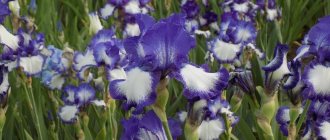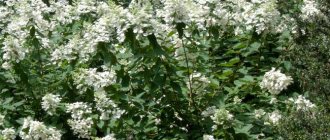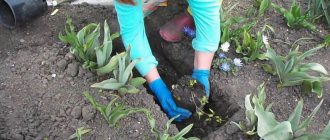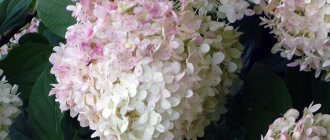Photo: i-spring.ru For their wonderful and unusual coloring, the Greeks named irises in honor of the goddess of the rainbow. And because of their amazing shape, people sometimes call them “northern orchids.” According to legend, these flowers appeared by the sea, where they sprouted from the tears of a woman who was waiting for her sailor husband during a storm. Like small beacons, bright buds illuminated the path. Today we will talk about irises and caring for them!
What types of irises are there?
Iris, also called Cockerel or Iris, is distinguished by its rich variety. There are about 800 species. They are painted in different colors, which is why the name of the genus is associated (“iris” translated from Greek means “rainbow”). More than 100 thousand varieties and hybrids have been cultivated. For convenience, they are combined into several groups (depending on external characteristics): bearded, bulbous, dwarf and others.
Bearded
Bearded irises are called varietal and hybrid irises, which are distinguished by the presence of a beard. It is created by dense villi located at the base of the lower petals (fouls). In appearance they resemble a “French goatee”. Although sometimes the fibers even cover the upper petals (standards), which gives the iris a special attractiveness.
Bearded irises are the most numerous and popular group. They come in a variety of colors and come in one or two colors.
They produce strong flower stalks 30–100 cm high, depending on the variety. Bearded irises come in different varieties, including French. But even they successfully take root in the climatic conditions of the middle zone.
On each bearded bush, 5–6 rather large flowers appear, which retain maximum decorative value for a week
Non-bearded
Irises that do not have pubescence are classified as beardless. This is the second most important group of colors. It includes all other varieties and varieties, so it is also quite numerous: it numbers several thousand.
Beardless specimens are valued for their graceful forms and huge variety of colors.
Bulbous
Bulbous are varieties and hybrid varieties of irises that are among the first to bloom (already in May). While the majority have rhizomes, this group is distinguished by the bulb from which shoots and roots grow. A characteristic feature is narrow leaves of an awl-shaped rather than xiphoid shape. The color of the inflorescences depends on the variety: blue, white, red, yellow, with patterns (spots, stripes) and others.
The leaves of the bulbous group look like bunches of green onions
Dwarf
Interesting types of garden iris are dwarf flowers. If medium-sized varieties reach 50–70 cm, and tall varieties reach 110 cm, then representatives of this group grow up to 40 cm. However, most varieties reach only 20 cm. This allows them to be used for decorating low flower beds, creating flower borders, beautiful ridges and mixborders.
Dwarf varieties of irises are suitable for creating rock gardens
Siberian
This group includes non-bearded specimens, which are particularly winter hardy. They can withstand frosts down to -35 degrees, which makes it possible to grow flowers in the climatic conditions of the Urals and Siberia. Among the Siberian irises, there are many varieties and hybrids bred on the basis of only three species:
- Cattail (Iris typhifolia).
- Blood red (Iris sanguinea).
- Siberian iris (Iris sibirica).
.
Japanese
Japanese irises include hybrids obtained from the sword-shaped variety or Kaempfer (Iris ensata). Breeders from the Middle Kingdom worked on their creation. These flowers are often used to decorate Japanese gardens, which is where their name comes from. They bloom closer to the second half of July. Suitable for creating all kinds of compositions, they look especially good on the shore of a country pond.
Japanese irises are distinguished by their original multi-colored petals.
Swamp
This group of varieties is derived from the marsh iris, which is also called yellow or calamus (Iris pseudacorus). In nature, it is indeed often found along the shores of freshwater bodies of water, and in appearance (with leaves) it looks like marsh calamus, which is what the name of the species is associated with. Decorative due to its inflorescences and attractive leaves.
Read more Caring for irises in autumn and preparing for winter
Swamp irises look beautiful in single plantings
Caring for the crop after flowering
If autumn replanting is not planned, then after the plant has finished blooming, you need to cut off the flower stalks. The sword-shaped leaves of the iris retain a certain decorative effect until the coldest weather. The white iris is famous for its especially beautiful leaves. The leaves that begin to turn yellow are cut off, and the foliage is completely removed in late autumn, cutting it off at a height of 10-15 cm above the ground.
We have listed the main stages of growing a crop such as irises. Planting and care in the open ground, upon closer examination, is completely uncomplicated, and the exquisite beauty of the plant will make the gardener forget about some of the difficulties in the agricultural technology of gardening.
What colors are irises
Irises of all varieties are painted in different colors, which can be seen in the photo. This allows for beautiful and unique combinations between different varieties, as well as with other plants. A huge number of these flowers with a variety of colors have been bred: snow-white, pastel pink, sky blue, coral and salmon, honey, bright yellow, yellowish-green, orange, peach, creme brulee, mustard-sunny, bright red, burgundy (burgundy), indigo, lilac, violet, fuchsia, gray-lavender, light brown (closer to brick).
The color palette of different types of irises is very diverse - from white to indigo and lilac
Of the entire range of colors, there are only those shades that are not found in plants, for example, rich green or classic black. Other colors can always be found.
Important! Irises can be painted in one or several shades. This creates additional opportunities for creating a unique landscape design.
Multi-colored types of irises look truly original
Storing irises before planting in spring
The dug up rhizomes of irises are stored in a dry and cool room where light does not penetrate. Container - a regular cardboard box, a wooden box. The main thing is not to use plastic, because it will cause the plants to rot. Before storage, the rhizomes are thoroughly dried, wrapped in paper or cloth, and placed neatly in a box.
Non-bearded irises can be stored in a pot of soil. Trim long roots and upper leaves, disinfect in a solution of potassium permanganate and dry thoroughly. Place in the ground, sprinkle a little on top and leave until spring. It should be planted in the spring together with a lump of earth.
Large varieties of irises
Large flowers are significant in size (height 80–110 cm, flower diameter 15–20 cm), so they can be used to decorate formal flower beds in the garden. The most popular varieties of large irises with photos and descriptions of flowers will help you become more familiar with their characteristics.
Bushwhacked
A recently developed variety with beautiful peach standards and dark lilac fouls. On the light spot of the lower petals, darker veins are noticeable, adding to the attractiveness. The Bushwax variety blooms later, beginning at the end of July or in the first half of August.
Bushwhacked - attracts with contrasting color combinations
Chasing Rainbows
The variety is distinguished by pale upper petals and reddish-brown fouls. Chasing Rainbow has an attractive appearance and large size, so it can be used in single plantings.
The inflorescences of Chasing Rainbows are large, corrugated, the color smoothly transitions from lighter to richer tones
Cimarron Trail
Cimmaron Trail is a bearded iris with multi-colored petals: from bright yellow to rich purple, the surface is corrugated.
Cimarron Trail was developed in the USA and began to spread in other countries in 2005.
Class Ring
Attractive petals of ruby-burgundy shades, the border of the fouls is wide, matching the tone of the standards. Snow-white and rich wine-red shades contrast well, making the plant look truly luxurious.
The Class Ring variety looks very impressive in any garden
Attention! The variety is tall - reaches 90 cm. It can be planted in front flower beds in compositions with low flowers and ornamental plants.
Classic Hues
Classic Hughes is a bright variety of irises. The upper petals are pale orange, the lower petals are bright yellow with a white center. The surface is lace, corrugated. It reaches a height of 65–75 cm. Bred in 2000. Managed to spread in Russia and other countries.
Classic Hues inflorescences are distinguished not only by their peach color, but also by their pleasant apricot aroma
Crowned Heads
Crown Hands is a variety of irises with satin-blue upper petals and bluish-white fouls. Recipient of numerous awards, including the Dykes Medal (2004).
Crowd Hands looks like a satin dress of bluish shades
Features of cultivation
Most inexperienced gardeners believe that growing irises is very difficult. However, in reality this is far from the case. Simply, in order for these plants to grow and develop normally, do not forget a few simple rules for caring for them:
- The rhizomes of such flowers grow in a horizontal direction, and at the same time part of it is exposed, as it comes to the surface. Before winter, it is recommended to cover these plants with peat or soil in order to protect them from freezing. In spring, this layer must be carefully removed.
- The peculiarity of such plants is that they are able to move. So, during the season they can move to the side by several centimeters. Therefore, it is recommended to plant them with a fan of leaf blades along the row. In this case, the rows will be more even.
- Bearded iris is planted using sand. Sand is poured into the bottom of the prepared hole in a heap, and the roots are straightened out along it. It should be taken into account that if the plant is deeply buried, it may die or may not bloom.
- Organic fertilizers cannot be used for fertilizing. Liquid mineral fertilizer is best suited.
The best varieties of re-blooming irises
Repeat-blooming irises produce flowers both at the beginning and at the end of summer: the second wave occurs at the end of August and the first half of September (if the autumn is warm enough). These are decorative, bright varieties that delight with pleasant flowers twice a season (subject to watering and fertilizing). The most beautiful varieties of re-blooming irises with photographs and names will help when planning your flowerbed design.
Immortality
Immortality is a tall variety (up to 75 cm). It blooms for the first time in early summer and forms inflorescences again in September. Belongs to the group of bearded irises, grows for many years, while the growth rate is small. Requires good lighting, but easily tolerates short-term partial shade.
Read more Landscape design of a site, garden with irises: photos and combinations
Snow-white Immortality inflorescences fit into the design of any flower bed
Jennifer Rebecca
Jennifer Rebecca is an iris variety that blooms in June and September, and in the southern regions even in October if the autumn is warm. Prefers well-lit, moist soils. It belongs to the tall varieties: it reaches a height of 85 cm.
Pastel pink inflorescences of Jennifer Rebecca look good against the dark lilac background of other varieties
Attention! The variety is winter-hardy and can withstand frosts down to -35 °C. Therefore, it can be grown in most Russian regions.
Bakwit
Buckwheat (Buckwheat) is a tall variety of irises, growing up to 90 cm. It blooms in mid-July and again in September. Refers to varieties of German selection. The lower petals have a light brown edge, forming a beautiful outline, which further enhances the beauty.
Bright yellow Buckwheat buds appear twice per season
Suga Blues
Sugar Blues is a repeat-blooming, tall variety of iris, reaching a height of 80–90 cm. Prefers well-moistened and lighted places. If fertilized and in good weather, it blooms again in mid-September. Sugar Blues is a variety of German selection, bred in 1985.
Solid Sugar Blues petals with darker veins combine well with yellow and orange inflorescences
Care features: watering and weeding
Irises (except for marsh species) require reasonable watering, strictly controlled during the budding period. In this phase, the plant should receive a sufficient amount of moisture; at other times, irises are watered only when the soil at the roots becomes completely dry.
Weeds must be removed throughout the growing season. Weeding is carried out manually, without using the usual garden tools, since the roots located close to the surface of the earth are damaged. A couple of times during the summer you will have to loosen the soil under the plant to improve root aeration. These manipulations are also carried out carefully, without violating the integrity of the rhizome shell.
Dried flowers must be removed, as pathogenic microorganisms or insect pests can settle in them. Both of them can significantly complicate the care of the plant and negatively affect its decorative effect.
Remontant varieties of irises
Remontant varieties are a category of re-blooming irises. The first wave occurs in June, less often in July, and the second in September or early October. Most often, re-blooming is observed in the southern regions, although it can often be seen in the middle zone.
Harvest of Memories
Harvest of Memories is a tall variety, reaching 90–100 cm in height. The first wave occurs in mid-summer, the second in early autumn. The inflorescences of this variety of iris are bright yellow and enliven the space.
The yellow petals of Harvest of Memories combine with the lilac tones of other crops
Mother Earth
The Mother Earth iris variety blooms in mid-July and September. The bush is tall, reaching 85–90 cm. The flowers are very beautiful - with shades of cream and lilac, their diameter is 12–15 cm. The plant is light-loving, but in the southern regions you can create a little partial shade for it.
Mother Earth in a lilac shade looks good in a bed with pink species
Rosalie Fiji
Rosalie Figge is a late-blooming variety with sparse dark blue oily flowers that glisten a little in the sun. This is an iris of German selection, it also comes in a rich lilac color. It looks very impressive.
Rosalie Figge is a rare variety that goes well with white and yellow tones
Pagan dance
Pagan Dance is a mysterious variety with the interesting name Pagan Dance. It is distinguished by a dark lilac color and looks great in single plantings, as well as in combination with orange inflorescences. Belongs to the medium-sized group - reaches a height of 70–75 cm. It begins to bloom in May, and for the second time - at the end of September and even at the beginning of October.
Pagan Dance is one of the most beautiful varieties of irises
When and where to plant irises
Blue irises, like all others, can be planted and replanted in spring, autumn or summer, immediately after flowering. Transplants are necessary every 3-5 years, since overgrown plants no longer produce full flowering and gradually degenerate.
All irises are light- and heat-loving; they prefer fertile, slightly acidic garden soils, well-drained and not exposed to close groundwater. Before planting the crop, the selected plot of land is dug up, adding phosphorus-potassium fertilizers (50-60 g/m2). Excessive soil acidity is neutralized with wood ash or dolomite flour (200 g/m2). Clay and loamy soils are diluted with peat and sand, and clay is added to sandy soils. Before planting, the area is treated with a fungicide, for example, “Fundazol”, or spilled with a weak solution of manganese.
New varieties of irises
Every year, breeders develop new varieties that differ in color, height, winter hardiness and other characteristics. Some of them are quickly gaining popularity.
Medici Prince
A tall bearded iris, whose name translates as “royally rich.” The petals are coral, pink, and turn into a rich burgundy. Each Prince Medici bush produces 8–10 inflorescences, but there can be more.
The spectacular Medici Prince variety looks beautiful both in the garden and as a cut flower.
Torero
Toreador is another tall bearded iris with apricot-orange upper petals and strawberry-red lower petals. This variety will appeal to lovers of pastel shades.
Torero – a pleasant flower with delicate colors
Magical Glow
Magic Glow is another tall variety. Peduncles reach 100 cm. Up to 9 buds are formed on each bush. The petals are flaming orange, the beard is red. The iris blooms in mid-summer.
The bright orange inflorescences of Magic Glow are ideally combined with dark lilac and rich blue shades
Cherry Blossom Song
Song of cherry blossoms is a very spectacular variety of tall iris (up to 90 cm). The upper petals are soft pink, the lower ones are cherry, with a purple tint.
Read more Siberian irises: description of plants, flowering time, best varieties
Each Cherry Blossom Song plant produces 7–9 buds; flowering begins in mid-July
Description
Tall flower (from 0.9 to 1.5 meters). The leaves are flat, long, and grow straight. The color varies from deep green to waxy-gray (almost blue). There are specimens with variegated leaves. 12-15 peduncles grow on a branched stem. The flowers have two upper petals that are slightly underdeveloped. They are yellow-golden in color, with a large orange spot. Sometimes false calamus irises are found in a delicate white color. Flowering occurs from the beginning of June until the 1st decade of July. Thickets of iris are very attractive to bees and butterflies; they are the main pollinators of the flower, which is considered an excellent honey plant.
The roots are powerful and branched, which ensures stable and rapid growth of iris flowers. In the marsh variety of this plant, the dissected root is initially light in color and quickly becomes brown. Preferred habitats are dry places on the banks of reservoirs, however, if the water level becomes too high, irises can withstand a long stay in water, even if the soil is flooded to a height of 0.3-0.4 meters. The flower does not tolerate low humidity well and ceases to be so beautiful and attractive.
It also has other names:
Bolotny; Air-shaped; False calamus.
Plant height is 75–165 cm. It has a branched root system up to 2 cm in diameter. The stem of the plant is dense. The leaves are green, sword-shaped. Bright yellow flowers are collected in a bunch of several branched stems. The shiny seeds ripen in a closed oblong capsule. The plant blooms from June to August. The fruits are formed in August.
Swamp iris is found in the wild on the banks of water bodies. Propagated by seeds. They are dense, so they do not sink in water. Often, the current carries them further, thus expanding the distribution zone. Cultivated iris is planted using rhizomes. It is divided into 3 parts. Each of them has kidneys.
It is the condition of the roots and their age that determines how well the flower is accepted. He loves high humidity. Grows well in shade, sun and partial shade. But the plant is intolerant to drafts. Loose sandy loam or loamy soil with a neutral or slightly acidic environment is suitable for flowers. Without transplanting, they can live on the same land for more than 10 years.
The most beautiful varieties of irises
It is especially difficult to rank the most beautiful varieties of irises. On the one hand, each gardener has his own taste, and on the other, these flowers are distinguished by an extraordinary variety of colors. Therefore, we present the most original varieties that are very popular among Russian summer residents.
Alchemist
Alchemist is a luxurious two-color iris. Looks good in single plantings, because it does not need any addition. You can plant low-growing ornamental plants along the edges of the flowerbed to create a general background.
Festive coloring of alchemist inflorescences lifts the mood
Swingtown
Bearded iris is lilac in color with soft blue bristles. The name of the variety is poetically translated into Russian as “City of Love”. It is distinguished not only by attractive inflorescences, but also by a pleasant cherry aroma.
Swingtown is rightly considered one of the best single-color varieties
Warrior King
Warrior King is a true king among irises. This variety will especially appeal to lovers of rich red color, closer to cherry or wine shade. A classic flower that always attracts attention. At the same time, red is not a flashy color, but quite calm.
The rich red inflorescences of the Warrior King variety look good against the backdrop of a well-groomed lawn
Night Game
A variety with the tempting name Night Game decorates the garden with dark lilac petals with a beautiful orange beard. The inflorescences are dark and go well with white, pink and orange flowers. The bushes are tall and look mysterious.
The glossy petals of the Night Game variety shine pleasantly in the sun
Border varieties of irises
Border varieties of irises belong to the category of low-growing ones - their height is in the range of 20–40 cm. They are well suited for framing paths and forming lush borders. Such plants need to be planted tightly to create a beautiful flower carpet. You can make a single-color or multi-colored flower bed and even “draw” an interesting floral pattern - with waves, zigzags, lines and other methods.
Beau
A miniature dwarf variety with lilac-purple petals. The core is purple in color, with a noticeable light yellow spot.
The iris variety Cavalier is an early flowering crop (late May)
Double Lament
Dark purple variety. Grows up to 30 cm. Blooms in mid-summer. The Double Cloak variety was bred in 1969. Therefore, it managed to spread throughout all countries.
Double Lament flower border creates a velvety feel
Lace Caper
Variety Lace Caper - golden iris of compact size. The petals are yellow, with corrugated edges and a golden beard.
Yellow Lace Caper peony flower border lifts the mood and enlivens the garden
Lumalite
Variety Lumalight with white petals turning into mustard. The beard is bright orange, very attractive.
All Lumalite petals are slightly corrugated
Tall irises in landscape design
The tallest varieties of irises reach a meter and attract attention. They are used to create long-range or middle plans of flower beds and other compositions . The background for them is thujas, junipers, ornamental shrubs, and berries.
A group of tall irises will look beautiful on the lawn, as well as on an area fenced off from the lawn grass with a border strip. You can choose peonies, lilies, oriental poppies as neighbors. Asters and phlox are suitable for the background.
Varieties of irises with a strong smell
Some varieties of irises not only decorate the area with unusually bright flowers, but also give a pleasant aroma. It can contain floral, fruity and even confectionery shades. It is felt especially well when plants are planted tightly.
Copatonic
The Kopatonic variety is an interesting iris that resembles a burning flame. Gives an interesting chocolate aroma.
The bright orange Copatonic flower is easily visible from anywhere in the garden.
Stop the Music
The “Stop the Music” variety smells like tangerine and also has hints of caramel. The inflorescence is bright red, scarlet.
Bright flowers of Stop the Music will enliven any flower bed
Arabian Story
The Arabian History variety can be safely included in the ranking of the most beautiful irises. Yellow-brown inflorescences lift the mood and stimulate the appetite with citrus and vanilla notes.
Arabian Story has an unusual color and a pleasant aroma with hints of oriental spices
Cloud Ballet
This monochromatic variety is considered the standard of iris aromas. The Cloud Ballet variety gives a pleasant floral scent with hints of caramel.
Cloud Ballet flower freshens the air in the garden and lifts your spirits
Soil preparation
It is not recommended to plant irises in any free space in the garden. The planting area should be carefully planned. The soil should be drained if the groundwater level is high. It is also better to choose a sunny place, since perennials bloom much worse in the shade. It is recommended to raise the flower bed by 15 cm.
Taking into account the characteristics of the soil on the site, it is necessary to add organic and mineral fertilizers to it. However, you should not add manure immediately before planting - it is better to do this a year in advance. Next, the soil is loosened, dug up again with a pitchfork and a flowerbed or bed is made with a slight slope to the south.
Dwarf irises Japanese iris
Depending on the variety, irises can be grown in one place for 5-10 years. Since they will grow very much during this period, be sure to take this into account when choosing an area for planting. Otherwise, the plant will not have enough nutrients and will be much weaker.











